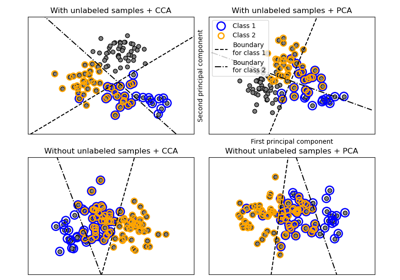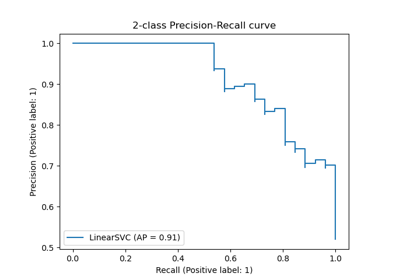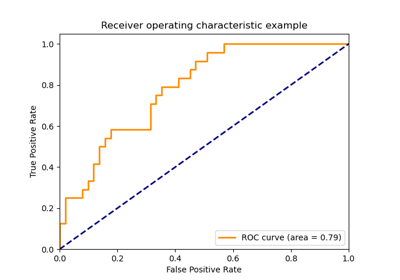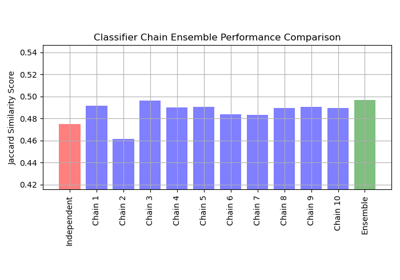sklearn.multiclass.OneVsRestClassifier¶
- class sklearn.multiclass.OneVsRestClassifier(estimator, *, n_jobs=None, verbose=0)[source]¶
One-vs-the-rest (OvR) multiclass strategy.
Also known as one-vs-all, this strategy consists in fitting one classifier per class. For each classifier, the class is fitted against all the other classes. In addition to its computational efficiency (only
n_classesclassifiers are needed), one advantage of this approach is its interpretability. Since each class is represented by one and one classifier only, it is possible to gain knowledge about the class by inspecting its corresponding classifier. This is the most commonly used strategy for multiclass classification and is a fair default choice.OneVsRestClassifier can also be used for multilabel classification. To use this feature, provide an indicator matrix for the target
ywhen calling.fit. In other words, the target labels should be formatted as a 2D binary (0/1) matrix, where [i, j] == 1 indicates the presence of label j in sample i. This estimator uses the binary relevance method to perform multilabel classification, which involves training one binary classifier independently for each label.Read more in the User Guide.
- Parameters:
- estimatorestimator object
An estimator object implementing fit and one of decision_function or predict_proba.
- n_jobsint, default=None
The number of jobs to use for the computation: the
n_classesone-vs-rest problems are computed in parallel.Nonemeans 1 unless in ajoblib.parallel_backendcontext.-1means using all processors. See Glossary for more details.Changed in version 0.20:
n_jobsdefault changed from 1 to None- verboseint, default=0
The verbosity level, if non zero, progress messages are printed. Below 50, the output is sent to stderr. Otherwise, the output is sent to stdout. The frequency of the messages increases with the verbosity level, reporting all iterations at 10. See
joblib.Parallelfor more details.New in version 1.1.
- Attributes:
- estimators_list of
n_classesestimators Estimators used for predictions.
- classes_array, shape = [
n_classes] Class labels.
n_classes_intNumber of classes.
- label_binarizer_LabelBinarizer object
Object used to transform multiclass labels to binary labels and vice-versa.
multilabel_booleanWhether this is a multilabel classifier.
- n_features_in_int
Number of features seen during fit. Only defined if the underlying estimator exposes such an attribute when fit.
New in version 0.24.
- feature_names_in_ndarray of shape (
n_features_in_,) Names of features seen during fit. Only defined if the underlying estimator exposes such an attribute when fit.
New in version 1.0.
- estimators_list of
See also
MultiOutputClassifierAlternate way of extending an estimator for multilabel classification.
sklearn.preprocessing.MultiLabelBinarizerTransform iterable of iterables to binary indicator matrix.
Examples
>>> import numpy as np >>> from sklearn.multiclass import OneVsRestClassifier >>> from sklearn.svm import SVC >>> X = np.array([ ... [10, 10], ... [8, 10], ... [-5, 5.5], ... [-5.4, 5.5], ... [-20, -20], ... [-15, -20] ... ]) >>> y = np.array([0, 0, 1, 1, 2, 2]) >>> clf = OneVsRestClassifier(SVC()).fit(X, y) >>> clf.predict([[-19, -20], [9, 9], [-5, 5]]) array([2, 0, 1])
Methods
Decision function for the OneVsRestClassifier.
fit(X, y)Fit underlying estimators.
get_params([deep])Get parameters for this estimator.
partial_fit(X, y[, classes])Partially fit underlying estimators.
predict(X)Predict multi-class targets using underlying estimators.
Probability estimates.
score(X, y[, sample_weight])Return the mean accuracy on the given test data and labels.
set_params(**params)Set the parameters of this estimator.
- decision_function(X)[source]¶
Decision function for the OneVsRestClassifier.
Return the distance of each sample from the decision boundary for each class. This can only be used with estimators which implement the
decision_functionmethod.- Parameters:
- Xarray-like of shape (n_samples, n_features)
Input data.
- Returns:
- Tarray-like of shape (n_samples, n_classes) or (n_samples,) for binary classification.
Result of calling
decision_functionon the final estimator.Changed in version 0.19: output shape changed to
(n_samples,)to conform to scikit-learn conventions for binary classification.
- fit(X, y)[source]¶
Fit underlying estimators.
- Parameters:
- X(sparse) array-like of shape (n_samples, n_features)
Data.
- y(sparse) array-like of shape (n_samples,) or (n_samples, n_classes)
Multi-class targets. An indicator matrix turns on multilabel classification.
- Returns:
- selfobject
Instance of fitted estimator.
- get_params(deep=True)[source]¶
Get parameters for this estimator.
- Parameters:
- deepbool, default=True
If True, will return the parameters for this estimator and contained subobjects that are estimators.
- Returns:
- paramsdict
Parameter names mapped to their values.
- property multilabel_¶
Whether this is a multilabel classifier.
- property n_classes_¶
Number of classes.
- partial_fit(X, y, classes=None)[source]¶
Partially fit underlying estimators.
Should be used when memory is inefficient to train all data. Chunks of data can be passed in several iteration.
- Parameters:
- X(sparse) array-like of shape (n_samples, n_features)
Data.
- y(sparse) array-like of shape (n_samples,) or (n_samples, n_classes)
Multi-class targets. An indicator matrix turns on multilabel classification.
- classesarray, shape (n_classes, )
Classes across all calls to partial_fit. Can be obtained via
np.unique(y_all), where y_all is the target vector of the entire dataset. This argument is only required in the first call of partial_fit and can be omitted in the subsequent calls.
- Returns:
- selfobject
Instance of partially fitted estimator.
- predict(X)[source]¶
Predict multi-class targets using underlying estimators.
- Parameters:
- X(sparse) array-like of shape (n_samples, n_features)
Data.
- Returns:
- y(sparse) array-like of shape (n_samples,) or (n_samples, n_classes)
Predicted multi-class targets.
- predict_proba(X)[source]¶
Probability estimates.
The returned estimates for all classes are ordered by label of classes.
Note that in the multilabel case, each sample can have any number of labels. This returns the marginal probability that the given sample has the label in question. For example, it is entirely consistent that two labels both have a 90% probability of applying to a given sample.
In the single label multiclass case, the rows of the returned matrix sum to 1.
- Parameters:
- Xarray-like of shape (n_samples, n_features)
Input data.
- Returns:
- T(sparse) array-like of shape (n_samples, n_classes)
Returns the probability of the sample for each class in the model, where classes are ordered as they are in
self.classes_.
- score(X, y, sample_weight=None)[source]¶
Return the mean accuracy on the given test data and labels.
In multi-label classification, this is the subset accuracy which is a harsh metric since you require for each sample that each label set be correctly predicted.
- Parameters:
- Xarray-like of shape (n_samples, n_features)
Test samples.
- yarray-like of shape (n_samples,) or (n_samples, n_outputs)
True labels for
X.- sample_weightarray-like of shape (n_samples,), default=None
Sample weights.
- Returns:
- scorefloat
Mean accuracy of
self.predict(X)wrt.y.
- set_params(**params)[source]¶
Set the parameters of this estimator.
The method works on simple estimators as well as on nested objects (such as
Pipeline). The latter have parameters of the form<component>__<parameter>so that it’s possible to update each component of a nested object.- Parameters:
- **paramsdict
Estimator parameters.
- Returns:
- selfestimator instance
Estimator instance.




